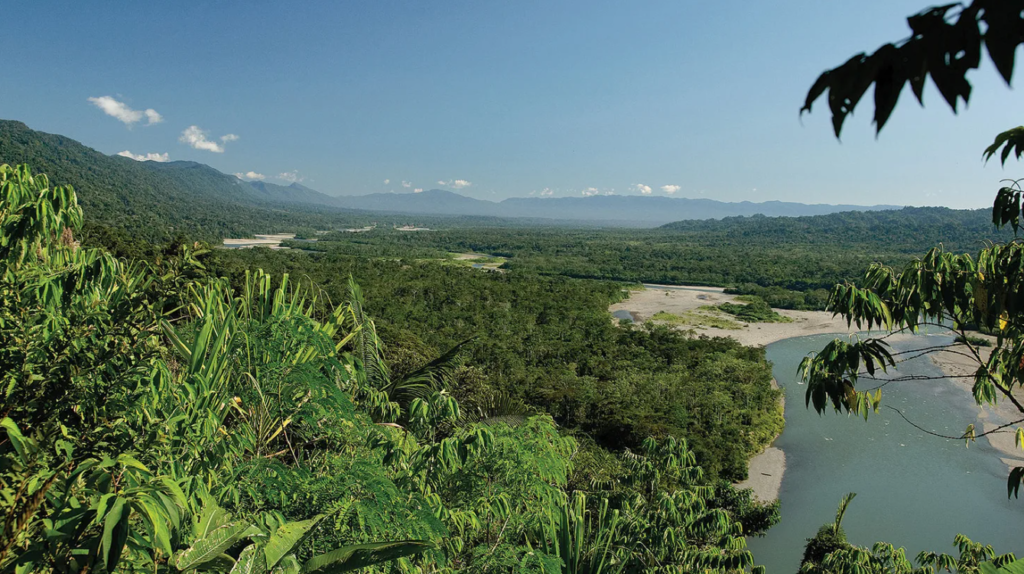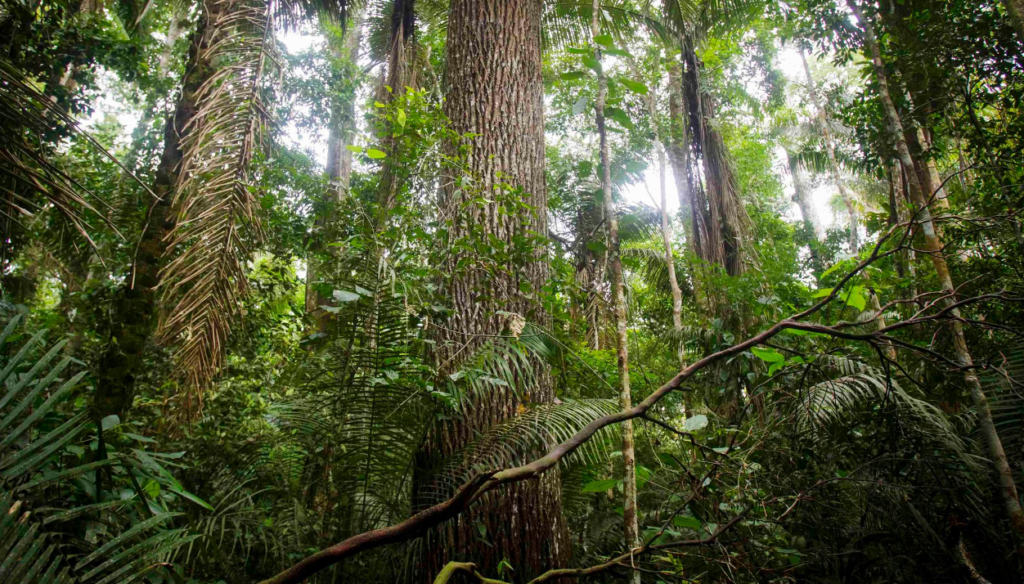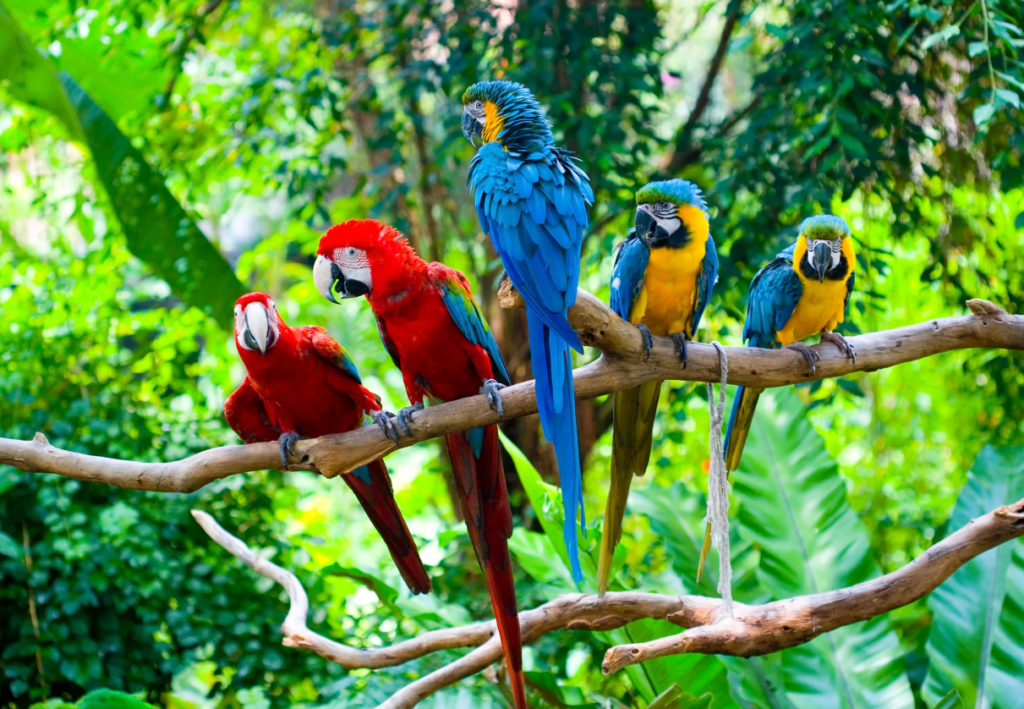
Table of Contents
The Manu National Park ecosystem is a biosphere reserve and natural world heritage site located in the Madre de Dios region of southeastern Peru. It is known for its exceptional biodiversity and for hosting a great variety of habitats and ecosystems.
The Manu National Park ecosystem is composed of a wide range of interrelated components. Some possible components of the Manu National Park ecosystem are presented below:
Flora in Manu National Park

Manu National Park, located in the Madre de Dios region of southeastern Peru, is a sanctuary of biodiversity and is home to a rich variety of flora. This exceptional ecosystem is home to a wide range of plant species that contribute to the beauty and balance of this natural environment.
Tropical forests:
Manu National Park is covered by vast tropical forests, which are some of the most diverse and dense on the planet. These forests are home to numerous species of trees, plants and epiphytes. Among the most emblematic trees are mahogany, cedar, tornillo and lupuna.
Lowland rainforests:
In the lowland rainforest areas of the park, a variety of trees and shrubs adapted to the humid and shady conditions can be found. It is common to find palms, ferns, lianas and a great diversity of herbaceous plants in this type of habitat.
Medicinal plants:
Manu National Park is known to be home to a large number of medicinal plants used by the local indigenous communities. These plants have healing properties and have been used for centuries in the traditional medicine of the region.
Orquídeas:
The park is famous for its abundance of orchids. It is estimated that there are more than 1,200 species of orchids in the region, representing one of the highest concentrations of these beautiful flowers in the world.
Heliconias and bromeliads:
Heliconias and bromeliads are characteristic plants of tropical forests and can be found in Manu National Park. These plants present vibrant colors and exotic shapes, and play an important role in pollination and water capture in the ecosystem.
Palm trees:
Palms are a prominent component of the park’s flora, with different species adapted to Manu’s diverse habitats. Aguaje, ungurahui and huasaí palms are some of the common palms in the region, providing fruit and shelter for local fauna.
Epífitas:
Epiphytes are plants that grow on other plants without being parasitic. In Manu National Park, a great variety of epiphytes can be found, such as bromeliads, orchids and lichens, which take advantage of the heights of the trees to obtain light and nutrients.
Mosses and ferns:
Mosses and ferns are important components of the park’s flora, especially in wetter, shaded areas. These plants not only contribute to the aesthetic beauty of the environment, but also play a vital role in the water cycle and nutrient capture in the soil.
The flora of Manu National Park is incredibly diverse and represents a valuable reserve of biodiversity. The conservation of this ecosystem is fundamental to guarantee the survival of plant species and to maintain the balance of the entire ecosystem.
Fauna in Manu National Park

Manu National Park is home to a rich fauna, including a great variety of mammals, birds, reptiles, amphibians and insects. Among the most emblematic animals are the jaguar, the giant anteater, the Amazonian tapir, various species of monkeys, macaws, among others.
Manu National Park is home to a rich diversity of fauna, with a wide variety of species adapted to the different habitats present in the park. Below are some examples of the fauna that can be found in Manu National Park:
Mammals in Manu National Park:
The park is known to be home to a large number of mammals. Among the emblematic species is the jaguar (Panthera onca), one of the largest felines in the Americas and a top predator in the ecosystem. Other species such as the giant anteater (Myrmecophaga tridactyla), the Amazonian tapir (Tapirus terrestris), the howler monkey (Alouatta), the squirrel monkey (Saimiri) and the capybara (Hydrochoerus hydrochaeris), the largest rodent in the world, can also be found.
Birds in Manu National Park:
Manu National Park is a paradise for bird lovers, as it is home to an amazing diversity of species. Colorful and exotic tropical birds such as the red and green macaw (Ara chloropterus), the toucan (Ramphastos ), the harpy eagle (Harpia harpyja), the hoatzin (Opisthocomus hoazin) and a variety of hummingbird species can be observed.
Reptiles and amphibians in Manu National Park:
The park is also home to a great variety of reptiles and amphibians. Species such as the boa constrictor (Boa constrictor), the green anaconda (Eunectes murinus), different species of aquatic and terrestrial turtles, as well as poison dart frogs and other amphibians can be found.
Fish and aquatic life of Manu National Park

Manu National Park is a sanctuary for a great variety of aquatic species and aquatic life in general. Its rivers, lakes and wetlands are home to an incredible diversity of fish and other aquatic life, contributing to the health and vitality of the ecosystem as a whole. Below, we will explore some highlights of the fish and aquatic life in Manu National Park.
Species diversity:
The rivers of Manu National Park are home to an impressive diversity of fish species. It is estimated that there are more than 1,000 species of fish in the Manu River basin, making it one of the most diverse aquatic ecosystems in the world. Among the most prominent species are the paiche (Arapaima gigas), the boquichico (Prochilodus nigricans), the doncella (Pseudoplatystoma), the shad (Brycon) and the carachama (Colossoma macropomum).
Migratory species:
Manu National Park is also home to migratory fish species that make long journeys to reproduce or find better feeding conditions. These fish can travel hundreds of kilometers in the rivers of the Amazon and Manu serves as an important corridor for these migrations. Some common migratory species are the dorado (Salminus brasiliensis) and the gamitana (Colossoma macropomum).
Ecological importance:
Fish play a fundamental role in the aquatic ecosystems of Manu National Park. They act as indicators of the health of rivers and lakes, and are key in food chains by serving as prey for birds, mammals and other fish. In addition, many fish contribute to the maintenance of water quality by removing organic matter and controlling aquatic insect populations.
Adaptations to the aquatic habitat:
The fish of Manu National Park have developed a variety of adaptations to survive in their aquatic environment. Some species have streamlined bodies and well-developed fins that allow them to swim quickly, while others have specialized lips to feed on aquatic plants or insects at the water’s surface. In addition, many fish have highly developed sensory systems to detect prey, predators and changes in the environment.
Conservation and threats:
Despite its biological richness, the aquatic ecosystems of Manu National Park face various threats. Overfishing, deforestation, water pollution and dam construction are some of the challenges facing fish and aquatic life in the region. The implementation of effective conservation measures, such as the creation of protected areas and the promotion of sustainable fishing practices, is fundamental to preserve the diversity and balance of Manu National Park’s aquatic ecosystems.
In summary, Manu National Park is a treasure trove for aquatic life lovers. Its rivers and lakes are home to an impressive diversity of fish species and other aquatic life. These aquatic ecosystems are vital to the ecological balance of the region and require continuous conservation efforts to ensure their long-term preservation.
Insects and arthropods in Manu National Park

Insects and arthropods are fundamental components of ecosystems around the world. These small creatures play vital roles in the food chain, nutrient cycling and pollination of plants. In Manu National Park, a great diversity of insects and arthropods are found, contributing to the richness and balance of the ecosystem.
Biodiversity of insects and arthropods:
Manu National Park harbors an extraordinary variety of insects and arthropods, representing a significant part of the area’s biodiversity. It is estimated that there are thousands of different species, many of which have not yet been catalogued and studied in detail. Among the most common groups are flying insects, such as butterflies, bees, flies and mosquitoes, as well as spiders, scorpions, centipedes and other arthropods.
Pollinators:
Insects, especially bees, are essential for plant pollination. These small pollinators help transfer pollen from one flower to another, allowing the reproduction and production of fruits and seeds. In Manu National Park, numerous species of bees and other insects play this crucial role in plant reproduction.
Decomposition
Insects and other arthropods play a fundamental role in the process of decomposition of dead organic matter. Through the action of beetles, worms, termites and other detritivores, plant and animal remains are decomposed, releasing nutrients back into the soil and contributing to the ecosystem’s nutrient cycle.
Pest control:
Some insects and arthropods act as natural pest controllers, maintaining balance in ecosystems and preventing uncontrolled outbreaks of certain species. For example, ladybugs and parasitoid wasps feed on insects harmful to crops, helping to regulate their populations.
Feeding of other animals:
Insects and arthropods are an important source of food for other animals in Manu National Park. Birds, bats, reptiles, amphibians and predatory mammals feed on these small creatures, forming part of the complex food webs of the ecosystem.
Unique adaptations:
Insects and arthropods have developed a wide range of adaptations to survive in different habitats and conditions in Manu National Park. Some insects have camouflage to mimic their environment, while others have defense mechanisms such as venom or spines. These adaptations allow them to face environmental challenges and compete for resources.
Symbiotic interactions:
Many insects and arthropods establish symbiotic relationships with other organisms. For example, ants have mutualistic associations with certain plant species, where they benefit from food and shelter, and in turn, protect the plant from herbivores. These interactions are vital to the health and survival of the species involved.
If you want to consult a tour of the Manu National Park or Abra Malaga, please contact us at info@ecoperutours.com or you can also call us at the following number (+51 930 930 254) Visit us in our Facebook.
